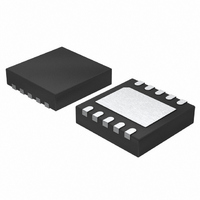MCP73223T-C2SI/MF Microchip Technology, MCP73223T-C2SI/MF Datasheet - Page 22

MCP73223T-C2SI/MF
Manufacturer Part Number
MCP73223T-C2SI/MF
Description
IC LI IRON PHOSPHATE CTRLR 10DFN
Manufacturer
Microchip Technology
Datasheet
1.MCP73123-22SIMF.pdf
(34 pages)
Specifications of MCP73223T-C2SI/MF
Battery Type
Lithium Iron Phosphate (LiFePO4)
Package / Case
10-DFN
Function
Charge Management
Voltage - Supply
4 V ~ 16 V
Operating Temperature
-40°C ~ 85°C
Mounting Type
Surface Mount
Product
Charge Management
Output Voltage
7.2 V
Output Current
130 mA to 1100 mA
Operating Supply Voltage
4.2 V to 13 V
Supply Current
700 uA
Maximum Operating Temperature
+ 85 C
Minimum Operating Temperature
- 40 C
Charge Safety Timers
No
Mounting Style
SMD/SMT
Temperature Monitoring
No
Uvlo Start Threshold
4.15 V
Uvlo Stop Threshold
4.05 V
Lead Free Status / RoHS Status
Lead free / RoHS Compliant
For Use With
MCP73X23EV-LFP - BOARD EVAL BATT CHARGER MCP73X23
Lead Free Status / Rohs Status
Lead free / RoHS Compliant
Available stocks
Company
Part Number
Manufacturer
Quantity
Price
Company:
Part Number:
MCP73223T-C2SI/MF
Manufacturer:
MICROCHIP
Quantity:
12 000
MCP73123/223
6.1
Due to the low efficiency of linear charging, the most
important factors are thermal design and cost, which
are a direct function of the input voltage, output current
and thermal impedance between the battery charger
and the ambient cooling air. The worst-case situation is
when
Preconditioning mode to the Constant Current mode. In
this situation, the battery charger has to dissipate the
maximum power. A trade-off must be made between
the charge current, cost, and thermal requirements of
the charger.
6.1.1
Selection of the external components in
crucial to the integrity and reliability of the charging
system. The following discussion is intended as a guide
for the component selection process.
6.1.1.1
The recommended fast charge current should be
obtained from the battery manufacturer. For exam-
ple, a 1000 mAh battery pack with 2C preferred fast
charge current has a charge current of 1000 mA.
Charging at this rate provides the shortest charge cycle
times without degradation of the battery pack
performance or life.
6.1.1.2
The worst-case power dissipation in the battery
charger occurs when the input voltage is at the
maximum and the device has transitioned from the
Preconditioning mode to the Constant Current mode.
In this case, the power dissipation is calculated using
Equation
EQUATION 6-1:
DS22191C-page 22
Where:
PowerDissipation
Note:
I
V
V
REGMAX
PTHMIN
DDMAX
the
Application Circuit Design
6-1.
COMPONENT SELECTION
Please consult with your battery supplier
or refer to the battery data sheet for the
preferred charge rate.
Charge Current
Thermal Considerations
device
= the maximum input voltage
= the maximum fast charge current
= the minimum transition threshold
voltage
=
V
DDMAX
has
transitioned
–
V
PTHMIN
Figure 6-1
I
from
REGMAX
the
is
Power dissipation with a 5V, ±10% input voltage
source, 500 mA ±10% and preconditioning threshold
voltage at 2V is calculated using
EQUATION 6-2:
This power dissipation with the battery charger in the
DFN-10
approximately 83C above room temperature.
6.1.1.3
The MCP73123/223 is stable with or without a battery
load. In order to maintain good AC stability in the
Constant Voltage mode, a minimum capacitance of
1 µF is recommended to bypass the V
This capacitance provides compensation when there is
no battery load. In addition, the battery and
interconnections appear inductive at high frequencies.
These elements are in the control feedback loop during
Constant Voltage mode. Therefore, the bypass
capacitance may be necessary to compensate for the
inductive nature of the battery pack.
A minimum of 16V rated 1 µF is recommended for the
output capacitor, and a minimum of 25V rated 1 µF is
recommended for the input capacitor in typical applica-
tions.
TABLE 6-1:
Virtually any good quality output filter capacitor can be
used, independent of the capacitor’s minimum
Effective Series Resistance (ESR) value. The actual
value of the capacitor (and its associated ESR)
depends on the output load current. A 1 µF ceramic,
tantalum, or aluminum electrolytic capacitor at the
output is usually sufficient to ensure stability.
6.1.1.4
The MCP73123/223 provides protection from a faulted
or shorted input. Without the protection, a faulted or
shorted input would discharge the battery pack through
the body diode of the internal pass transistor.
Capacitors
PowerDissipation
MLCC
X7R
X5R
package
External Capacitors
Reverse-Blocking Protection
-55C to +125C
-55C to +85C
Temperature
MLCC CAPACITOR EXAMPLE
=
Range
will
5.5V 2V
2011 Microchip Technology Inc.
–
raise
Equation
550mA
the
BAT
Tolerance
±15%
±15%
temperature
6-2.
=
pin to V
1.925W
SS
.












